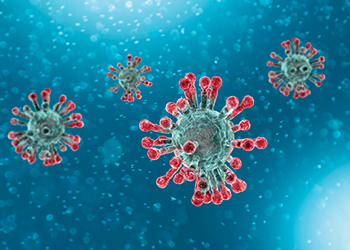Indoor air not geared to tackle coronavirus
OLIVER ZIMMERMANN, CEO of Condair Group*, comments on the lack of humidity control regulations for public buildings and the subsequent impact on possible coronavirus transmission and health.
01 April 2020
Public building occupants are being exposed to increased risk from viruses, such as the coronavirus, because the regulations on indoor air quality (IAQ) are falling short of current scientific knowledge. Maintaining IAQ at above 40 per cent relative humidy (RH) has been scientifically shown to reduce viral cross-infection, including coronavirus and influenza. Yet out-of-date regulations on the topic result in buildings such as hospitals, offices and schools experiencing dangerously low humidity levels every winter.
Studies, such as Casanova et al 20101, have specifically examined humidity’s role in coronavirus transmission. This study showed that coronavirus was deactivated fastest when exposed to a mid-range humidity (50 per cent RH), rather than dry (20 per cent RH) or damp (80 per cent RH) air. There are many other studies, dating back from the 1940s to now, that all indicate that an indoor humidity of 40-60 per cent RH has a positive impact on cross infection and people’s susceptibility to viruses.
Alongside Casanova et al 2010, summaries of 25 other such studies are listed on Condair’s website (condairgroup.com).
 |
|
Oliver Zimmermann |
The building services sector accepts this indoor humidity level as being best practice, with many professional organisations endorsing a mid-range humidity for health in their recommendations. However, there are no official regulations that set an acceptable range of indoor humidity for public places. Therefore, building designers, who are driven to reduce energy consumption and costs, do not commonly include humidity control in their plans.
The seasonality of viruses, such as coronaviruses and influenza, are further evidence of humidity’s role in their transmission. Indoor air is much drier in the winter and this corresponds to the rise of infections.
Strategies to contain the spread of the virus frequently cite the assumption that infections will probably drop as warmer weather returns, and indoor humidity levels naturally return to a mid-range 40-60 per cent RH.
It doesn’t need to be this way!
A healthy indoor humidity can be maintained during winter if buildings incorporated humidification as part of the ventilation system. This would significantly reduce seasonal flu transmission and save thousands of lives globally every year.
Advice on mitigating the risk from coronavirus largely focuses on hand hygiene and avoiding unwell people. However, viral cross-infection occurs via the air as well as from physical contact. The general public are largely helpless to manage this important aspect of infection control.
The responsibility to manage IAQ ultimately falls on building owners and operators to safeguard occupant health. This is particularly true with regards healthcare facilities, where people are most vulnerable and at risk to airborne infections, such as coronavirus and influenza. The general public are being failed in this respect with no health authority in the world specifying a minimum humidity level in waiting rooms or wards.
Given the overwhelming scientific evidence for indoor humidity of 40-60 per cent RH being an effective infection control mechanism, and the viral pandemic on our doorstep, regulatory bodies must listen to science and set acceptable indoor humidity levels for health.
* Condair Group is a leading specialist in humidification and commercial humidity control.
Reference:
1 - Effects of Air Temperature and Relative Humidity on Coronavirus Survival on Surfaces. Lisa M. Casanova, Soyoung Jeon, William A. Rutala, David J. Weber, Mark D. Sobsey. Applied and Environmental Microbiology Apr 2010, 76 (9) 2712-2717; DOI: 10.1128/AEM.02291-09
- Towards sustainable systems in the region
- Emerson unveils new condensing units
- Right retrofits hold key to green targets
- Evaporative cooling strategies for the Gulf
- Indoor air not geared to tackle coronavirus
- Pegler registers solid growth in Mideast
- Emicool deploys energy-saving solution



